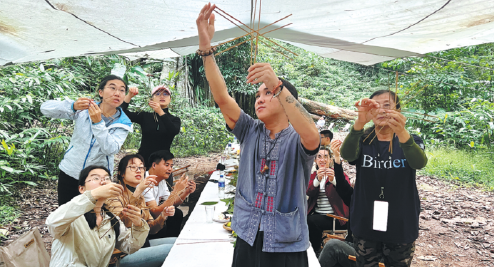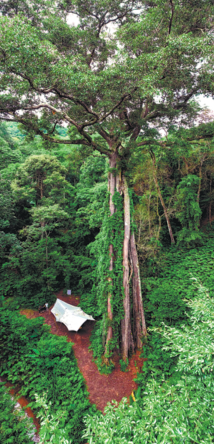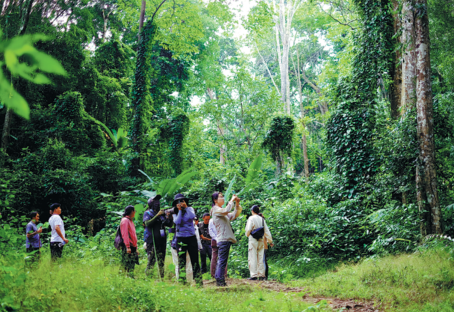Going wild in the wilderness
Yunnan's Xishuangbanna offers a natural appeal, especially with rainforest hikes that explore its biodiversity, Deng Zhangyu reports.

As winter switches much of the country into a fridge, if not a freezer, tropical Xishuangbanna Dai autonomous prefecture in Southwest China's Yunnan province offers a goldilocks climate. That is, not too hot, not too cold — but just right.
It's these mild temperatures that make it a hotspot for travelers during this otherwise-cold season. They flock to the region to explore its biodiversity for both education and entertainment.
Chen Sinan, a local who runs a company that offers tailored rainforest hikes, has been busy recently, especially since many parents are traveling with their children during the school winter vacation.
Xishuangbanna is located in Yunnan's far south. It's widely known as a "wonderland of plants and animals" and as a home to wild Asian elephants. It is where several ethnic groups inhabit for generations.
"Visitors also want to know about tropical forests," says Chen, whose tours are fully booked until the beginning of March.
"Many parents also hope their children will learn about nature while having fun."
The prefecture's governor, Dao Wen, says study tours and jungle treks for families are becoming star offerings this year.
Xishuangbanna received over 54 million visitors from January to September in 2023 and another 670,000 during the three-day New Year holiday.
On a recent visit to the area, I joined a group of photographers, birdwatchers and hikers, as we were guided by Chen through pristine tropical rainforest one sunny afternoon in December.
We hiked for 3 kilometers, picnicked in the rainforest and climbed trees in a jungle hidden behind a mountain range about a half-hour drive from the prefecture's main city, Jinghong.
The initially unremarkable trek became increasingly incredible as the tall palms gave way to trees as high as skyscrapers that created a canopy that blocked out most of the light.
"Welcome to the rainforest. We just walked through a little grassland to start," Chen joked in reference to these towering trees.
As we continued on, he often stopped, pointed at a plant and talked about its function in the ecosystem. He also alerted us to the presence of various insects that camouflaged themselves so well that we wouldn't have noticed them if they hadn't been pointed out.
We encountered a beautiful black widow that had just finished weaving its web, a couple of mating locusts, a large lizard busily scouting for food and a green bamboo snake snoozing in a tree. At one point, a river crab tried to scuttle onto a hiker's shoe.
Even though I'd wrapped myself in clothing to seal out any bugs, especially mosquitoes, I was still bitten by a golden ant that was larger than my fingernail.
It hurt. A lot!
In another palm forest, we found a murder victim — a tall tree we thought had been cut down by humans until Chen explained it'd recently been killed by competing trees.
It's a reminder of the law of the jungle, in which everything fights — in every sense — to survive.
We'd come to enjoy the beauty of a place that's ultimately the result of a battle, often to the death.
Trees fight to grow as high as possible to catch sufficient sunlight. This sometimes requires them to sacrifice root depth to extend their presences above ground as much as possible. But the downside of this upward push is that it can make them easier to push over, as was the case with the tree we saw, which had a weak and shallow root system.
Among the countless killers with leaves are "stranglers" like banyan figs. Birds drop their seeds onto tree branches, where they grow roots downward along the trunks and gradually choke their hosts, stealing their nutrients and light until they die of deprivation.
"It's harsh," Chen said. "Many trees have their own ways to fight back, just like we humans struggle greatly to make a living."
One tree we saw resembled a giant hedgehog covered with spines to fend off vines. Another sheds its bark to slough off lianas and was totally nude when we encountered it.
Still, we stumbled upon more victims of the strangler figs as we continued deeper in. The brutality and ingenuity of these plants is something I wouldn't have imagined unless I'd witnessed it.
We arrived at the picnic spot where we enjoyed fruit and tea, and coffee made using quality beans grown in Pu'er, a city that's a roughly two-hour train ride away. Here, we were also able to climb a 60-meter-high banyan by rope, under the supervision of two professionals.
Unfortunately, I ran out of energy after ascending only a few meters. I sat in a chair in front of the tree, sipping tea, watching the others climb. It was quiet, there was no mobile phone signal, so the only stimulation came from nature.
Hikers are also able to enjoy cultural programs, such as performances by elephant-foot drum dancers like 24-year-old Xiao Yan, who belongs to the Dai ethnic group. He has spent the past decade studying the folk art, which takes its name from the fact that its lead percussion instrument looks like the eponymous pachyderm's leg. The influx of tourists has created enough demand, so that Xiao has been able to set up a studio to stage more performances and train several apprentices.
"Thanks to the increase in families visiting, I can make a good living as a dancer," he said.
Dancing in the rainforest is new to him. But the popularity of jungle hikes bodes well for his prospects, he believed.
As the sky darkened, we made our way out of the rainforest. Men drove past, carrying the picnic materials on their motorbikes. Then, the only sounds were of unseen insects.
And so I left the jungle, where so many plants fight fiercely, now once again a dark and mysterious place.
The next day, I visited the Chinese Academy of Sciences' Xishuangbanna Tropical Botanical Garden to learn more about the region's flora and fauna. It's the largest of its kind in the country and is home to the most plant species.
It is also a research center with lots of experts, able to serve as informed guides.
It even provides tailored services for families with specialized interests. For instance, it offers a leaf-tasting tour so that visitors can experience different degrees of sour, sweet, bitter and spicy. The garden also puts on night tours to enable encounters with nocturnal bugs like fireflies.
My guide told me the increase of study tours by families this year has made it harder to get night tickets, which must be booked at least a week in advance during peak season.
"Visitors want to not only have fun but also to learn about nature," she said.






Today's Top News
- Israel's Gaza takeover plan widely condemned
- S. Korea visa waiver spurs surge in travel interest
- Top cities signal easing to support property market
- Ties bolster heritage protection
- Gaza 'takeover' will ignite another horrific chapter for the Middle East: China Daily editorial
- STAR shines for innovative companies






























